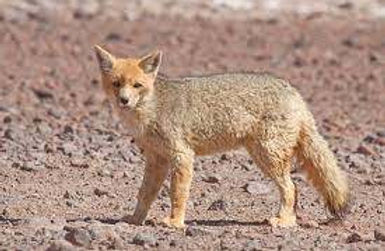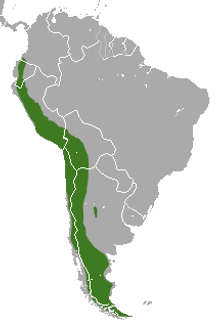Culpeo(Lycalopex culpaeus)
They are sometimes known as the zorro culpeo, Andean zorro or Andean fox. It is intermediate in size between a red fox and a coyote. The average weight of the male is 11.4 kg, while the typically smaller females average 8.4 kg. Overall, a weight range of 5-13.5 kg has been reported. Total length can range from 95-132 cm, including a tail of 32-44 cm in length. The pelt has a grizzled appearance. The neck and shoulders are often tawny to rufous in color, while the upper back is dark. The bushy tail has a black tip.

Habitat
Its distribution extends from Ecuador and Peru to the southern regions of Patagonia and Tierra del Fuego. Some populations live in southern regions of Colombia. It is most common on the western slopes of the Andes, where it inhabits open country and deciduous forests.
Diet
These omnivorous animals are opportunistic predators that will take any variety of prey. They are mainly carnivores hunting on rodents, rabbits, birds, and lizards. Culpeos also eat eggs of different reptiles and birds, carrion and sometimes plants and fruit.

Breeding
Little is known about the mating system in culpeos. The breeding season occurs between August and October. After a gestation period of 55-60 days, the female gives birth usually to between 2 and 5 pups. Young are born naked, with the eyes closed. They weigh around 170 grams. Pups are usually weaned at 2 months of age and reach full size when they are 7 months old. Reproductive maturity is reached after about 1 year of age.
Population
According to IUCN, the culpeo is abundant and widespread throughout its range but no overall population estimate is available. Currently, this species is classified as Least Concern (LC) on the IUCN Red List and its numbers today are stable.
Threats
Main threats to Culpeos have been hunting and trapping for fur (although trade has decreased in the last decade) and persecution to reduce predation on livestock and poultry. Although illegal, the use of poison to reduce or prevent livestock losses caused by Culpeos is still widespread in some parts of its range, including remote areas of the high Andes. Habitat loss does not appear to be an important threat to this species. Predation by feral and domestic dogs may be important in some areas.
Conservation
Legislation
Included on CITES – Appendix II. The Argentine legislation about Culpeos is contradictory. Culpeos were considered "Endangered" by a 1983 decree of the Argentine Wildlife Board , due to the numbers of Culpeo pelts traded during the 1970s and early 1980s. However, trade at the national level and export of Culpeo pelts was legal during that entire period and currently remains legal. Culpeos are legally hunted in 6 Argentine provinces and a bounty system is in place in two of them. The Culpeo's endangered status has never been revised in spite of marked changes in the fur trade and reports from monitoring programmes. However, it has been listed as Near Threatened in the most recent national Red List. The Tierra del Fuego population has been legally protected since 1985.
In Peru, the Culpeo is not considered endangered, but permits are issued by the government to hunt individuals depredating on livestock. Similarly, in Chile, where the species is listed as Least Concern, the Hunting of Culpeos is illegal (since 1980), but permits may be obtained for predator control . In Bolivia, although the fur export was banned in 1986 and hunting is illegal, Culpeos are commonly killed to reduce predation on livestock .
The Argentine Wildlife Board is starting to develop a management plan for canids that will include the Culpeo. Five regional workshops that included wildlife agency officials from provincial governments, wildlife traders, conservationists, and scientists have been held in Argentine Patagonia to coordinate efforts to manage Culpeo populations in a sustainable manner and reduce sheep predation.
Presence in protected areas
In Chile, the Culpeo occurs in the large majority of protected areas distributed throughout the country, encompassing all the habitats where it can be found. However, only 14% are large enough to support viable populations. In Argentina, the species occurs in 12 national parks and several provincial reserves, the majority of which probably support viable populations. In Peru, Culpeos occur in 18 and in Bolivia in nine of each country's national system of protected areas.
Presence in captivity
The Culpeo is common in zoos throughout Chile and Argentina.